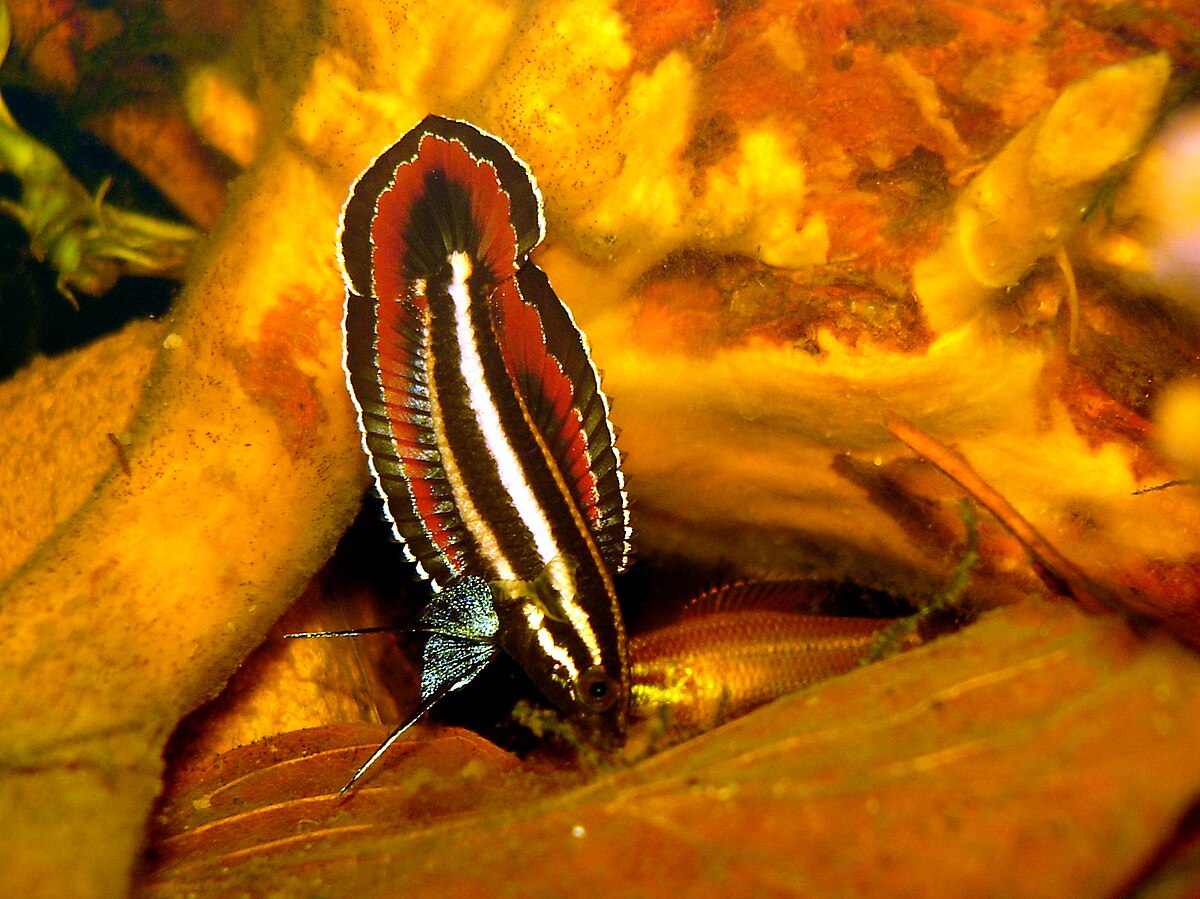Sentag Gourami

A Jewel of the Blackwater: A Guide to Caring for Parosphromenus Sentang
For the dedicated aquarist seeking a unique and rewarding challenge, the diminutive and dazzling Parosphromenus sentang, or the Sentang licorice gourami, presents an alluring prospect. Hailing from the peat swamp forests of Southeast Asia, these enigmatic little fish are a testament to the delicate beauty of their threatened natural habitats. This in-depth guide will provide you with the essential knowledge to successfully keep and potentially breed these captivating creatures in your home aquarium.
Parosphromenus sentang belongs to a group of labyrinth fish known for their intricate colouration and specific care requirements. Their care is not for the faint of heart, demanding a meticulous approach to water chemistry and a commitment to providing a specialised environment. However, the reward for such dedication is the opportunity to observe the fascinating behaviours and stunning breeding displays of this rare gem.
Natural Habitat and Its Importance
To truly understand the needs of Parosphromenus sentang, one must first appreciate their natural environment. They inhabit blackwater peat swamps, characterised by slow-moving, deeply stained water that is incredibly soft and acidic. The dark tea-colour of the water is a result of tannins and other humic substances released from decaying leaves, wood, and other organic matter. This environment has shaped their evolution, making them intolerant of hard, alkaline water and sudden changes in their surroundings. Replicating these conditions is paramount to their health and vitality in captivity.
Aquarium Setup: Crafting a Blackwater Haven
Creating an appropriate habitat is the cornerstone of successful Parosphromenus sentang care. Due to their small size and shy nature, a nano or small aquarium is ideal.
Tank Size: A pair or a small group can be comfortably housed in a tank of 20-30 litres (approximately 5-8 gallons). A larger tank of 45-60 litres will allow for a more stable environment and the potential to keep a larger group or a community of similarly demanding species.
Filtration: Gentle filtration is crucial. A small, air-driven sponge filter is an excellent choice as it provides adequate biological filtration without creating excessive water movement, which these fish dislike.
Substrate and Décor: A dark, soft substrate such as sand will help to showcase their colours and mimic their natural environment. The tank should be heavily aquascaped with a network of caves, bogwood, and dense vegetation. Small clay pots, PVC pipes, or film canisters can be used to create the small caves that are essential for their security and for breeding.
Lighting: Dim lighting is a must. Floating plants such as Salvinia, Pistia, or Amazon Frogbit are highly recommended to diffuse the light and provide additional cover. The use of tannins from leaf litter will also naturally reduce light penetration.
Leaf Litter and Botanicals: The addition of dried Indian almond leaves, alder cones, and other botanicals is not merely decorative; it is fundamental to creating the blackwater conditions these fish need. These materials release beneficial tannins and humic substances, which help to lower the pH and create a more natural and antibacterial environment.
Recommended Tank Setup:
| Feature | Recommendation |
|---|---|
| Tank Size | 20-45 litres |
| Filtration | Air-driven sponge filter |
| Substrate | Dark sand |
| Lighting | Dim, with floating plants |
| Décor | Bogwood, caves, dense planting |
| Botanicals | Indian almond leaves, alder cones |
Water Parameters: The Key to Success
The water chemistry for Parosphromenus sentang is non-negotiable and requires careful management. It is highly recommended to use reverse osmosis (RO) water remineralised to the desired parameters, as tap water in most areas of the UK is too hard and alkaline.
Water Parameter Chart:
| Parameter | Recommended Range | Notes |
|---|---|---|
| Temperature | 22 – 28°C (72 – 82°F) | Stable temperature is crucial. |
| pH | 3.5 – 6.5 | Aim for the lower end of the scale. |
| General Hardness (GH) | 0 – 5 dGH | Very soft water is essential. |
| Carbonate Hardness (KH) | 0 – 2 dKH | A low KH is necessary to maintain a low and stable pH. |
| Nitrates | Below 10 ppm | These fish are sensitive to poor water quality. |
Regular, small water changes are preferable to large, infrequent ones to maintain stability. A weekly change of 10-15% is a good starting point.

Diet and Feeding: A Micropredator’s Needs
Parosphromenus sentang are micropredators and thrive on a diet of small, live foods. They can be reluctant to accept dried foods, and a varied diet of live and frozen options is essential for their health and to encourage breeding behaviour.
Suitable Foods:
- Live daphnia
- Live or frozen brine shrimp (Artemia)
- Live or frozen cyclops
- Microworms
- Vinegar eels
- Small grindal worms
Feed in small amounts once or twice a day. A well-established aquarium with plenty of leaf litter and botanicals will also provide a natural source of infusoria for the fish to graze on.
Social Behaviour and Tank Mates
These are peaceful but shy fish. While males can be territorial towards each other, a small group can be kept in a suitably sized and decorated aquarium. It is often best to keep them in a species-only setup to cater to their specific needs.
If tank mates are desired, they must be small, peaceful, and thrive in identical blackwater conditions. Suitable companions could include:
- Boraras species (e.g., Chili Rasbora)
- Pygmy Corydoras (Corydoras pygmaeus)
- Other small, peaceful blackwater-loving fish.
Breeding Parosphromenus Sentang
Breeding these gouramis is considered the pinnacle of achievement for their keepers. It is a challenging but incredibly rewarding experience.
Conditioning: To encourage spawning, condition the pair with a rich diet of live foods. The male will intensify in colour, displaying stunning blues, reds, and blacks as he tries to entice a female.
The Spawning Site: The male will select a small, dark cave and build a bubblenest within it. The entrance to the cave is often very small, just large enough for the fish to enter.
The Spawning Process: The courtship ritual is a captivating display. The male will flare his fins and dance around the female. Spawning occurs within the cave, where the female releases her eggs, which are then fertilised by the male and placed in the bubblenest.
Fry Care: The male will guard the eggs and fry. The eggs typically hatch within 24-48 hours, and the fry will become free-swimming a few days later. At this point, they require microscopic foods such as infusoria or commercially available liquid fry food. After a week or so, they can be moved on to newly hatched brine shrimp.

Common Health Issues
Parosphromenus sentang are delicate and can be susceptible to common freshwater fish diseases, particularly if their specific water requirements are not met.
- Fungal infections: Often a result of poor water quality or stress.
- Bacterial infections: Can occur if the fish are stressed or injured.
- Velvet (Oodinium): A parasitic infection that can be common in labyrinth fish.
The best preventative measure is to maintain pristine and stable water conditions. Quarantining new additions is also essential to prevent the introduction of diseases.
Conclusion: A Rewarding Endeavour
Caring for Parosphromenus sentang is undoubtedly a labour of love. It requires a significant commitment to maintaining a specialised environment that mirrors their natural blackwater habitats. However, for the aquarist willing to invest the time and effort, the reward is the chance to house a truly remarkable and beautiful fish. Their intricate behaviours and the challenge of breeding them offer a deeply fulfilling experience, making the Sentang licorice gourami a true jewel of the aquarium hobby.


